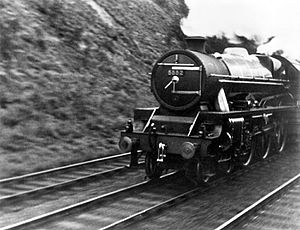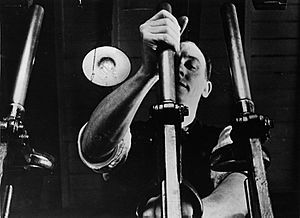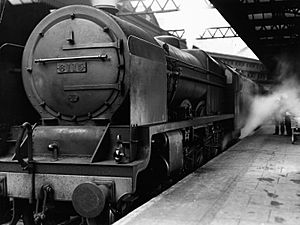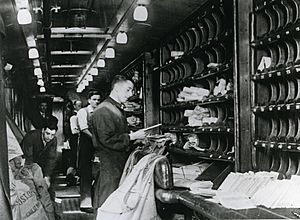Night Mail facts for kids
Quick facts for kids Night Mail |
|
|---|---|
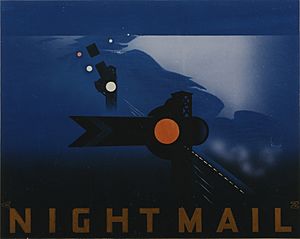
Film poster designed by Pat Keely
|
|
| Directed by | Harry Watt Basil Wright |
| Produced by | Harry Watt Basil Wright |
| Written by | W. H. Auden |
| Narrated by | Stuart Legg John Grierson |
| Music by | Benjamin Britten |
| Editing by | Basil Wright |
| Studio | GPO Film Unit |
| Distributed by | Associated British Film Distributors |
| Release date(s) | 4 February 1936 (Premiere) |
| Running time | 23 minutes |
| Country | United Kingdom |
| Language | English |
| Budget | £2,000 |
Night Mail is a famous British documentary film from 1936. It was directed by Harry Watt and Basil Wright. The film was made by the General Post Office (GPO) Film Unit.
This 23-minute film shows a special train that carried mail every night. It traveled from London to Scotland. The film also highlights the postal workers who sorted letters on the moving train. John Grierson and Stuart Legg narrated the film. It ends with a special poem written by W. H. Auden and music by Benjamin Britten. The train featured in the film was the LMS Royal Scot Class Scots Guardsman.
Night Mail first showed on 4 February 1936 in Cambridge, England. It quickly became a classic and was praised by critics. Many later films and adverts copied its style. It is considered a masterpiece of the early British documentary film movement. A sequel, Night Mail 2, was released in 1987.
Contents
What the Film is About
The film shows how mail was delivered by train in the 1930s. It focuses on a special train called the "Postal Special." This train was only for carrying post, not passengers.
The night train traveled from Euston station in London to Glasgow, Scotland. It then went on to Edinburgh and Aberdeen. The film shows exciting shots of the train speeding along the tracks. It also includes views of the countryside from above.
Inside the train, you see postal workers sorting mail. These scenes were actually filmed in a studio set. The film really highlights how important these postal workers were in delivering letters.
How the Film Was Made
Starting the Project
In 1933, Stephen Tallents started working for the General Post Office (GPO). He brought the EMB Film Unit with him, and John Grierson became its new head. This group became the GPO Film Unit. By 1936, the GPO was the UK's largest employer. They wanted to improve their public image and show how important their services were.
The GPO Film Unit made films to teach people about postal services. They also wanted to show the GPO and its employees in a positive light. This was important because postal workers' wages had fallen. The GPO wanted to boost their morale.
The idea for Night Mail came from this goal. Directors Harry Watt and Basil Wright were asked to make a film about the overnight postal train. This train went from London to Glasgow.
Getting Ready to Film
In 1935, Harry Watt and Basil Wright started working on the film. Basil Wright traveled on the postal train to get ideas for the script. He listened to conversations to make the dialogue sound real. Harry Watt then wrote the full script.
At first, the GPO wanted a simple information film. But the idea grew into something bigger. They wanted to show the "reality" of working life for postal employees.
A film crew was put together. This included cameramen Pat Jackson, Jonah Jones, and Henry "Chick" Fowle. Alberto Cavalcanti joined as the sound director. He mixed the sound, dialogue, and music.
John Grierson also hired the famous poet W. H. Auden to help. Auden worked as Watt's assistant director. Watt initially didn't think much of Auden, but later praised his talent. The GPO gave them about £2,000 to make the film.
Filming the Movie
On Location and in the Studio
Filming for Night Mail took four months. Most of the film was shot without sound. The sound, dialogue, and music were added later. The people you see in the film were real postal workers. Their dialogue was based on real conversations.
The film was shot on 35 mm film. Portable cameras were used for outdoor shots. These cameras were often heavy, so most scenes were filmed using a tripod. The crew recorded background sounds in different places. For example, they recorded trains passing at Bletchley station. They even asked train drivers to blow their whistles as they passed.
The scenes with railway workers were filmed near Hemel Hempstead. The crew walked along the tracks to get shots of trains and signals. A railway employee warned them about oncoming trains. The crew talked with the workers and filmed them at work.
Filming at Crewe station took several days. The crew set up their own lights and power cables. They had to pack up quickly when the postal train arrived. After filming, the reels were sent for processing. The crew would then view the footage at a local cinema.
Basil Wright filmed the aerial shots from an airplane. Harry Watt filmed the inside and other outdoor scenes. The postal workers in the sorting coach were real GPO employees. However, these scenes were filmed on a special set at the GPO's studio in Blackheath. The workers swayed to make it look like they were on a moving train.
Auden's first job was to film mail bags being moved at London's Broad Street station. A fake postal train was set up there to record sounds. These shots were later used in the Crewe sequence.
Henry Fowle captured some amazing shots. He filmed a mail bag being picked up by a net at high speed. He leaned out of the coach while his colleagues held his legs! Fowle also solved the problem of recording train sounds. They used a model train from Basset-Lowke in the studio. They pushed it along a track at the right speed to get the perfect sound.
The crew also filmed at Beattock Summit in Scotland. Pat Jackson took a risky shot from the train's coal tender. He held a silver sheet to reflect light onto the driver. A bridge almost knocked the reflector off! The crew continued into Scotland to film the final shots at dawn.
The Famous Poem Sequence
After seeing a rough version of the film, the team decided it needed a new ending. John Grierson thought the film showed the "machinery" of mail delivery. But what about the people who write and receive letters? He wanted a spoken poem with music.
W. H. Auden was given the job of writing this "verse commentary." He wrote the poem, called "Night Mail," at the film unit's office. He timed it to match the rhythm of the train's wheels. Many lines were changed or removed to fit the visuals.
The poem sequence starts slowly and then speeds up. Stuart Legg narrated most of it at a very fast pace. He had to pause to catch his breath during recording! As the train slows down, John Grierson reads the final, calmer verse. This poem made Night Mail more than just a film about mail. It became a work of art about loneliness and friendship.
Benjamin Britten, a 22-year-old composer, was hired to create the music. Harry Watt told him not to make it "highbrow." Britten was given artistic freedom. He used an orchestra of ten musicians. He even used a compressed air cylinder and sandpaper to create train sounds! The music was recorded in January 1936.
Film Release
Night Mail first showed on 4 February 1936 at the Cambridge Arts Theatre. The audience loved it and gave it "enormous applause." It was the only GPO film released commercially that year.
There was some disagreement about who got credit for directing and producing. Basil Wright and Harry Watt both felt they deserved more credit. John Grierson refused to change the credits.
The GPO promoted Night Mail with a big advertising campaign. They made posters and held special screenings. The film was shown in regular cinemas before the main feature. Even though many people watched it, the film didn't make a lot of money. This was because of poor contracts for short documentaries. In 2007, Night Mail was released on DVD after being digitally restored.
Film's Impact and Later Works
Night Mail was a big success, but the GPO Film Unit faced challenges. Its films couldn't compete with big commercial movies. The unit eventually closed in 1940. It then became the Crown Film Unit.
John Grierson and other members of the GPO Film Unit continued to make documentaries. Grierson is often called the "father of documentary film" for English speakers. Night Mail is seen as a great example of their teamwork. It's a beloved film about the Royal Mail, the British people, and the power of real-life films.
The film is still popular today. Many people admire it, and school children sometimes memorize the "Night Mail" poem. It has even been copied in adverts and TV shows. In 2000, Night Mail was named the Best Railway Film of the Century.
Sequel Poem
In 1986, 50 years after the original film, poet Blake Morrison wrote a poem for a sequel. This film was called Night Mail 2. It showed how mail was delivered in modern times. Morrison even used a line from Auden's original poem that had been cut.
British Rail Advert
In 1988, British Rail made a TV advert called "Britain's Railway." It used the first part of Auden's poem, along with some new lines.
Other Media
The music Benjamin Britten wrote for Night Mail was first performed in a concert in 1997. It was published in 2002. It's one of Britten's most detailed film scores.
The British band Public Service Broadcasting created a song called "Night Mail." It was on their 2013 album, Inform-Educate-Entertain.
In 2014, Night Mail was honored on a set of Royal Mail stamps. These stamps featured famous GPO Film Unit films.
The electronic musician Aphex Twin also used parts of the poem. He sampled the opening lines in his song Nightmail 1. This song was released in 2017.


